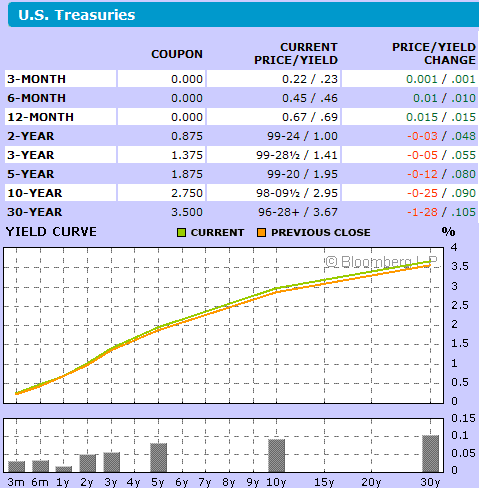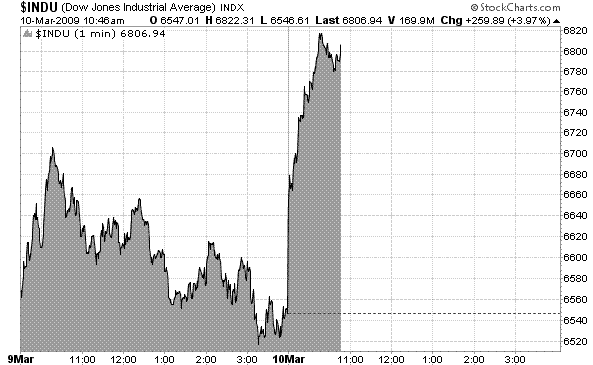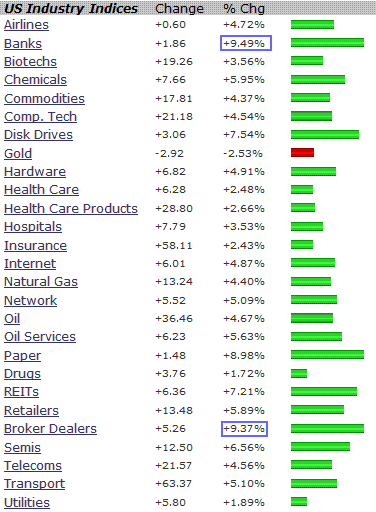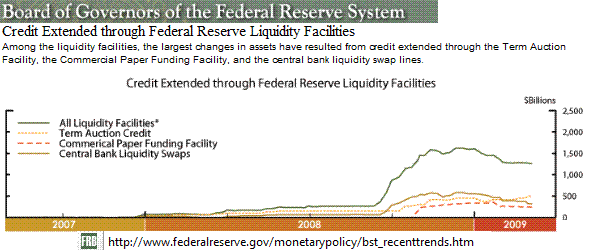Yesterday was an uninspired trading session. MBS outperformed the supply weary TSY curve ($63bn this week) while stocks sat stagnant. The Fed continues to provide a steady and supportive bid to the GSE MBS market and overseas accounts remain buyers of government guaranteed GN coupons.
Today is Class A notification day...this is setting up to be a non-event as many accounts have already rolled to the April coupon. The switch from the March coupon to the April Coupon will result in MBS prices falling 8 to 12 ticks (this is called "THE DROP")...do not fret this a normal function of the TBA MBS market.
MBS is off the morning lows and bids are slowing improving while TSYs sell and the yield curve steepens...Read more about the current MBS environment in THIS BLOG POST
Since 5pm yesterday...
FN30______________________________________
FN 4.0 -------->>>> -0-06 to 98-30 from 99-04
FN 4.5 -------->>>> -0-03 to 101-01 from 101-04
FN 5.0 -------->>>> -0-01 to 102-13 from 102-14
FN 5.5 -------->>>> +0-01 to 102-30 from 102-29
FN 6.0 -------->>>> +0-02 to 103-17 from 103-15
GN30______________________________________
GN 4.0 -------->>>> -0-06 to 99-03 from 99-09
GN 4.5 -------->>>> -0-03 to 101-11 from 101-14
GN 5.0 -------->>>> -0-01 to 102-24 from 102-25
GN 5.5 -------->>>> +0-02 to 103-09 from 103-07
GN 6.0 -------->>>> +0-02 to 103-20 from 103-18

So far today stocks are feeling speculatively optimistic enough to cover their short positions (maybe I should say slightly less pessimistic?).

The reason for interim positivity (besides all out selling exhaustion) was a memo from Citibank CEO Vikram Pandit that stated Citibank was having its best quarter since 2007. Look what sectors are leading the rally...

This morning Ben Bernanke gave a speech at the Council on Foreign Relations in Washington, D.C. His topic: Financial Reform to Address Systemic Risk.
Here is a brief summary of his speech using excerpts from the prepared statement...
We must have a strategy that regulates the financial system as a whole, in a holistic way, not just its individual components. In particular, strong and effective regulation and supervision of banking institutions, although necessary for reducing systemic risk, are not sufficient by themselves to achieve this aim.
Today, I would like to talk about four key elements of such a strategy.
Too Big to Fail
We must ensure a robust framework--both in law and practice--for consolidated supervision of all systemically important financial firms organized as holding companies.
Looking beyond the current crisis, the United States also needs improved tools to allow the orderly resolution of a systemically important nonbank financial firm, including a mechanism to cover the costs of the resolution.
Strengthening the Financial Infrastructure
Given how important robust payment and settlement systems are to financial stability, a good case can be made for granting the Federal Reserve explicit oversight authority for systemically important payment and settlement systems.
We should review regulatory policies and accounting rules to ensure that they do not induce excessive procyclicality--that is, do not overly magnify the ups and downs in the financial system and the economy.
Finally, we should consider whether the creation of an authority specifically charged with monitoring and addressing systemic risks would help protect the system from financial crises like the one we are currently experiencing.
Ben again re-iterates that the Federal Reserve will not allow major institutions to fail
Procyclicality in the Regulatory System
We should review capital regulations to ensure that they are appropriately forward-looking, and that capital is allowed to serve its intended role as a buffer--one built up during good times and drawn down during bad times in a manner consistent with safety and soundness.
Further review of accounting standards governing valuation and loss provisioning would be useful, and might result in modifications to the accounting rules that reduce their procyclical effects without compromising the goals of disclosure and transparency.
In the Q&A Bernanke was clear to clarify that he did not support the suspension of" mark to market"
Systemic Risk Authority
Financial stability, however, could be further enhanced by a more explicitly macroprudential approach to financial regulation and supervision in the United States. Macroprudential policies focus on risks to the financial system as a whole.
Some commentators have proposed that the Federal Reserve take on the role of systemic risk authority; others have expressed concern that adding this responsibility would overburden the central bank. The extent to which this new responsibility might be a good match for the Federal Reserve depends a great deal on precisely how the Congress defines the role and responsibilities of the authority, as well as on how the necessary resources and expertise complement those employed by the Federal Reserve in the pursuit of its long-established core missions.
BIG BROTHER IS WATCHING!!!
The US Treasury Department will auction $34,000,000,000 in US debt at 1pm.
Illustrating the Federal Reserve's role in Financial Markets....






